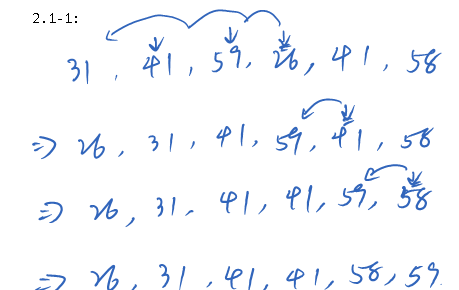2.1-1:

2.1-2:
NON-INCREASING-INSERTION-SORT(A)
for j: 1~ length(A)-1:
if(A[j] < A[j-1]):
key = A[j]; t = j-1;
while(A[t] < key && t>=0):
A[t+1] = A[t];
t--;
A[t] = key;
return A;
2.1-3:
// Assumption: If there're duplicated elements, only return
// the index of the first element.
LINEAR-SEARCH(A, key)
for i: 0~ length(A)-1:
if(A[i] == key) return i;
return NIL;
Proof:
loop invariant: all the elements has been searched doesn't equal to "key"
Initialization: At the start of each iteration, no element has been searched,
loop invariant holds.
Maintenance: if there's element equal to the "key", it would terminate
immediately; therefore as long as the algorithm is on going, it would hold the loop invariant.
Termination: if the algorithm runs until the end of the loop, didn't
terminate, it means no element equal to the "key".
Therefore the algorithm is correct.
2.1-4:
Input: Given two n-bit integers, stored in n-element arrays A and B (the lower index stores the least significant bit), where each element only stores 0 or 1.
Output: An array C of (n+1) elements stores the sum of that two n-bit number
Pseudocode:
N-BIT-NUMBER-SUM(A,B)
// initialization
carry = 0;
for i: 0 ~ length(A) -1:
C[i] = carry;
carry = A[i] & C[i];
C[i] ^= A[i];
carry |= B[i];
C[i] ^= B[i];
C[i] = carry; // here i = length(A)
return C;







 本文详细解析了非递增插入排序算法的过程,并通过线性搜索算法的实现与证明展示了其正确性。此外,还提供了一个n位数求和的伪代码示例。
本文详细解析了非递增插入排序算法的过程,并通过线性搜索算法的实现与证明展示了其正确性。此外,还提供了一个n位数求和的伪代码示例。
















 116
116

 被折叠的 条评论
为什么被折叠?
被折叠的 条评论
为什么被折叠?








